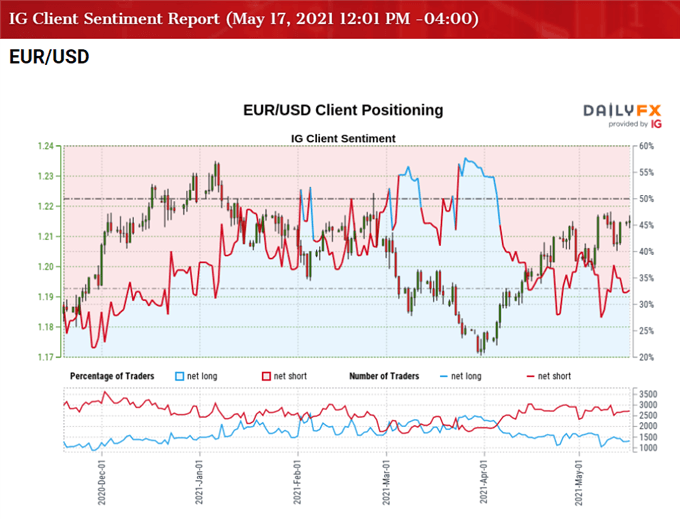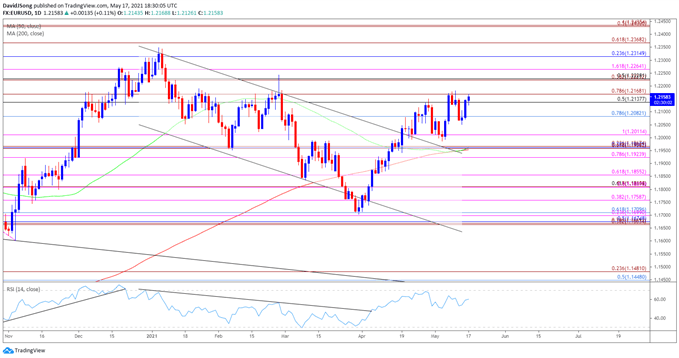EUR/USD Rate Talking Points
EUR/USD attempts to retrace the decline following the update to the US Consumer Price Index (CPI) as a growing number of Federal Reserve officials warn of a transitory rise in inflation, and the exchange rate may stage another attempt to test the February high (1.2243) as it carves a series of higher highs and lows.
EUR/USD Eyes February High Again as Dovish Fed Rhetoric Persists
EUR/USD appears to have reversed course ahead of the monthly low (1.1986) as comments from Fed Vice Chair Richard Clarida largely mirrors the dovish remarks from Governor Christopher Waller, with the recent advance in the exchange rate generating a positive slope in the 50-Day SMA (1.1962) as the moving average snaps back from the 200-Day SMA (1.1953).
Looking ahead, it remains to be seen if the Federal Open Market Committee (FOMC) Minutes will influence EUR/USD as Vice Chair Richard Clarida emphasizes that “there’s still a deep hole in the labor market,” with the permanent voting-member on FOMC going onto say that “it may take more time to reopen a $20 trillion economy than it did to shut it down”while speaking at the Atlanta Fed’s 2021 Financial Markets Conference.
As a result, Clarida pledges to “give advance warning” before scaling back the emergency measures, and it seems as though the majority of the FOMC will continue to strike a dovish tone ahead of the next interest rate decision on June 16 as the vice chair argues that the US economy “has not made substantial further progress” amid the below-forecast print for the April Non-Farm Payrolls (NFP) report.
In turn, EUR/USD may stage another attempt to test the February high (1.2243) as the FOMC appears to be on track to retain the current course for monetary policy, and a further appreciation in the exchange rate may fuel a larger tilt in retail sentiment as the crowding behavior from 2020 resurfaces.
The IG Client Sentiment report shows 35.87% of traders are currently net-long EUR/USD, with the ratio of traders short to long standing at 1.79 to 1.
The number of traders net-long is 17.25% higher than yesterday and 8.84% higher from last week, while the number of traders net-short is 2.95% higher than yesterday and 8.15% lower from last week. The rise in net-long interest has helped to alleviate the crowding behavior as only 34.89% of traders were net-long EUR/USD last week, while the decline in net-short position comes as the exchange rate appears to have reversed course ahead of the monthly low (1.1986).
With that said, EUR/USD may stage another attempt to test the February high (1.2243) as Fed officials brace for a transitory rise in inflation, and the 50-Day SMA (1.1962) may continue to develop a positive slope as it snaps back from the 200-Day SMA (1.1953).
EUR/USD Rate Daily Chart
Source: Trading View
- Keep in mind, EUR/USD established a descending channel following the failed attempt to test the April 2018 high (1.2414), but the decline from the January high (1.2350) may turn out to be a correction in the broader trend rather than a change in market behavior as the exchange rate trades back above the 50-Day SMA (1.1962) to break out of the bearish trend.
- The Relative Strength Index (RSI) showed a similar dynamic as the oscillator reversed ahead of oversold territory to break out of a downward trend, but the string of failed attempts to push above 70 warns of a larger correction in EUR/USD as it struggles to test the February high (1.2243).
- Nevertheless, the recent advance in EUR/USD has generated a positive slope in the 50-Day SMA (1.1962) as the moving average snaps back from the 200-Day SMA (1.1953), and the exchange rate may stage another attempt to test the February high (1.2243) as it carves a series of higher highs and lows.
- Need a close above the Fibonacci overlap around 1.2140 (50% retracement) to 1.2170 (78.6% expansion) to bring the 1.2220 (38.2% expansion) to 1.2260 (161.8% expansion) region on the radar, which largely lines up with the February high (1.2243), with the next area of interest coming in around 1.2320 (23.6% retracement).
— Written by David Song, Currency Strategist
Follow me on Twitter at @DavidJSong




Be the first to comment